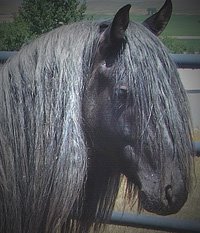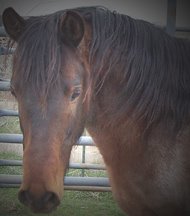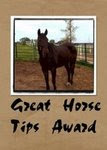I'm in the middle of a series spawned, somewhat accidentally, by my belief that an ideal endurance rider is one who does his or her best to achieve leanness, cardiovascular endurance, and a high level of functional strength. Only by being committed athletes ourselves can we be worthy partners for our horses. Endurance is a team sport. Play it lean and strong.
While strength is primarily the result of exercise, leanness is about 80% diet. In Part Three, I introduced "eating clean" as a major factor in a rider's ability to attain and maintain a low body fat ratio. Eating clean means fueling your body with the substances it was designed to ingest -- a lifestyle so simple that maintaining it requires only that you follow a few, simple rules. Eating Clean Rule #1, you'll recall from Part Three, is: Don't eat anything with a barcode. Today, we move on to Rule #2.
Eating Clean Rule #2: Sugar is the devil.
Uh-oh. You knew I was going there, didn't you? Congratulations -- you guessed it. I'm going there, and I'm going all the way. Sugar is the devil. It is poison. You shouldn't eat it. Despite what those ludicrous HFCS promotions say to the contrary, sugar is not acceptable, even in moderation. Except in its natural combination with fiber and multitudinous nutrients, such as in fruit, sugar is nothing but bad for you. Period.
I could end this post here. You've already read the critical information. But, I suspect a number of you, like me, aren't satisfied with what when you could have why. So, I'll carry on a bit and give you some resources with which to follow up on your own.
First of all, since we're discussing leanness, you need to understand that sugars are simple carbohydrates. The body converts all carbohydrates to glucose, which is a useful fuel. Unfortunately, most people eat far too much carbohydrate and wind up with an overabundance of glucose in their cells. Because glucose is toxic in large amounts, and because your body is designed to store energy in case of later starvation, you come equipped with a means of dealing with unburned glucose: you turn it to fat.
"It's not fat that gets stored in your fat cells," explains one of my favorite nutrition blogs, Mark's Daily Apple, in this post, "-- it's sugar." The post goes on to explain how too much carbohydrate (sugar) in the diet eventually leads to insulin resistance, which everyone knows is half a click away from diabetes (read: obesity, cardiac disease, nerve damage, blindness, and early death). High price to pay for that afternoon Pepsi.
Prefer an alternative method of payment? How about cancer? As Dr. Patrick Quillin explains in his inexpertly-written, but highly informative, book Beating Cancer with Nutrition, "sugar feeds cancer." It's the perfect meal for mutant cells. Considering that cancer cells form regularly in all our bodies throughout our lifetimes (and are usually conquered by our immune systems) I am disinclined to offer them a welcoming buffet.
I should clarify here that sugar, like processed food, is found in more than the obvious sources. As far as your body is concerned, simple starches are virtually indistinguishable from those white granules you put on your (barcoded) Wheaties. White flour and its many children (pasta, breads, crackers, etc.) are all, essentially, sugars. You've heard that "muffins are for people who don't have the balls to order cake for breakfast?" I'm afraid it's necessary to extend that statement to encompass your morning bagel, English muffin, and toast as well.
Then, there are the hidden sugars. Variously labeled as high fructose corn syrup, rice syrup, dextose, fructose, glucose, sucrose, and everything else gross, an astonishing quantity of sugar hides in supposed "health foods" such as yogurt, fruit juices, salad dressings, smoothies, energy bars and beverages, frozen entrees, soy milk, peanut butter (of the Jiffy and Skippy variety), and just about everything else with a barcode. Even whole grains impact the body as sugar, though in a less dramatic fashion than do the dreaded "simple carbs." Low-fat and fat-free products are almost always packed with sugar, not to mention a horrifying array of additives that don't come from anything so natural as sex or seeds.
By the way, you don't still think you're getting away with anything by choosing diet drinks and other products featuring artificial sweeteners, do you? Good. Because saccharin, aspartame, sucralose, and their evil cousins are well-documented carcinogens, allergens, and wreakers of general havoc on organs from skin to kidney to brain. As a special bonus, many of them enhance your appetite. Just what you need when trying to get lean! (For an excellent discussion artificial sweeteners and other food additives, check out a book called Excitotoxins: The Taste that Kills by Russell Blaylock.)
Note that your friends at the FDA, who are well aware of the complications associated with artificial sweeteners...and the USDA, who are acquainted with the damaging effects of over consumption of carbohydrates...still merrily approve and recommend their use. Just another reason I don't take Big Brother's advice.
Here's the good news: While sugar and its man made relatives are addictive substances, addictions can be broken. All it takes is a healthy dose of willpower applied without exception for a sufficient period of time. For most people, 14-28 days' effort will break the strongest bonds, leaving you free, over time, to transform into one of those annoying people who is genuinely un-tempted by the office chocolate bowl, Friday donuts, and the Coke machine down the hall.
Incidentally, much of these health nuts' seemingly-ironclad commitment is based in their bodies' heightened insulin sensitivity due to low sugar consumption over the long term. That's a fancy way of saying that they know a small slice of birthday cake will leave them feeling like crap for the rest of the afternoon. (It'll make everyone else feel like crap, too, for different reasons...but most of them won't realize they feel like crap because, sadly, they always feel like crap. And to make themselves feel better, they 'll buy another soda. Which will make them feel like crap. Recognize yourself? Check out Dr. Neal Barnard's book Breaking the Food Seduction to better understand -- and conquer -- food cravings.)
Of course, if you're following Eating Clean Rule #1, you don't need to worry about any of this. Nature doesn't overload you with sugar any more than it prints barcodes on itself. Some would argue that fruit is an exception. While it's true that sedentary people should not overindulge, as the carbohydrates in fruit do need to be burned lest they be stored as fat, fruit offers myriad nutritional benefits and is, by far, the best source of sweetness in a clean diet.
Right, then. Many of you have made the clever observation that these two Eating Clean Rules eliminate almost all the products that fill most westerners' grocery carts and kitchen cupboards. Some of you are staring at your screens in horror, wondering what in the name of Kellogg's Frosted Pop Tarts is left to eat. Surely, you say, if she really lives by these rules, she'll drop dead before finishing this post!
Not so. I assure you, eating clean (and getting lean) has nothing whatsoever to do with starvation. "Eating clean," you'll recall, means fueling your body with the substances it was designed to ingest. Here they are:
Vegetables. Fruits. Legumes. Meats. Eggs. Nuts. Seeds. Plant oils. Grains. Milk. Period.

Science and human nature being what they are, there's plenty of room for debate even within the above categories. I'll address a couple of the most prominent issues in upcoming posts, and then we'll move on to the strength part of the equation. For now, suffice it to say that most honest nutritionists and researchers would agree that following Eating Clean Rules #1 and #2 would eliminate the vast majority of our collective roadblocks on the path to leanness and longevity...and as endurance riders, isn't longevity what we're all about?
_________________________________________________________
Related Posts
Fit to Ride, Part One: Going for the Goal
Fit to Ride, Part Two: Vice and Advice
Fit to Ride, Part Three: Eating Clean
Fit to Ride, Part Five: Eating Green
Fit to Ride, Part Six: Milk Got You?
Straight Sailing: Thoughts on Fitness for Endurance Riders
_________________________________________________________
Want to read more posts like this one? We deliver!


 _________________________________________________________
_________________________________________________________









